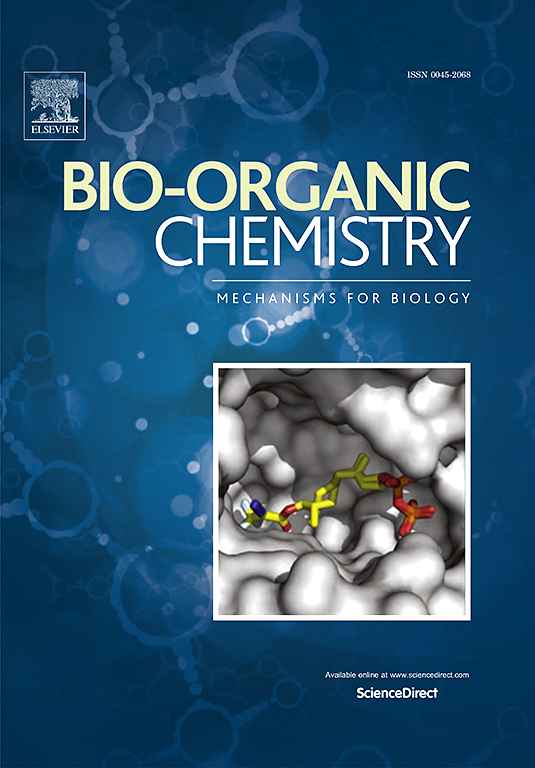Design, synthesis, and biological evaluation of Schiff-Base Isoxazole hybrids: Exploring novel antimicrobial agents
IF 4.5
2区 医学
Q1 BIOCHEMISTRY & MOLECULAR BIOLOGY
引用次数: 0
Abstract
The rise of antimicrobial resistance necessitates the development of novel therapeutic agents. This study presents the design, in silico studies, synthesis, and biological evaluation of Schiff-base isoxazole hybrids as potential antimicrobial agents. Computational approaches, including molecular docking, molecular dynamics (MD) simulations, density functional theory (DFT) calculations, and ADMET predictions, guided the design and assessment of these compounds. DFT analysis identified compound A20 (−0.0919 Hartree) as having the lowest energy gap, suggesting high reactivity. Molecular docking revealed strong binding affinities (−11.3 to −7.00 kcal/mol) comparable to standard antimicrobial drugs, while MD simulations confirmed the stability of protein-ligand interactions. ADMET analysis predicted favorable pharmacokinetic properties. Biological evaluations revealed promising antimicrobial potential of the synthesized compounds. A20 showed significant antifungal activity (MIC: 64 μg/mL), while A7 exhibited notable antibacterial activity (MIC: 1024 μg/mL). Further A20 in combination with standard antifungal drug fluconazole is exhibiting outstanding antifungal potential. Leading towards the possibility of developing a new drug against resistant microbial strains through combination therapy.

随着抗菌药耐药性的增加,有必要开发新型治疗药物。本研究介绍了作为潜在抗菌剂的席夫碱异恶唑杂化物的设计、硅学研究、合成和生物学评价。包括分子对接、分子动力学(MD)模拟、密度泛函理论(DFT)计算和 ADMET 预测在内的计算方法为这些化合物的设计和评估提供了指导。密度泛函理论分析确定化合物 A20(-0.0919 哈特里)具有最低的能隙,表明其具有高反应性。分子对接显示了与标准抗菌药物相当的强结合亲和力(-11.3 至 -7.00 kcal/mol),而 MD 模拟证实了蛋白质配体相互作用的稳定性。ADMET 分析预测了良好的药代动力学特性。生物学评价显示,合成的化合物具有良好的抗菌潜力。A20 显示出明显的抗真菌活性(MIC:64 μg/mL),而 A7 则显示出显著的抗菌活性(MIC:1024 μg/mL)。此外,A20 与标准抗真菌药物氟康唑联用,也显示出卓越的抗真菌潜力。这为通过联合疗法开发出抗耐药性微生物菌株的新药提供了可能。
本文章由计算机程序翻译,如有差异,请以英文原文为准。
求助全文
约1分钟内获得全文
求助全文
来源期刊

Bioorganic Chemistry
生物-生化与分子生物学
CiteScore
9.70
自引率
3.90%
发文量
679
审稿时长
31 days
期刊介绍:
Bioorganic Chemistry publishes research that addresses biological questions at the molecular level, using organic chemistry and principles of physical organic chemistry. The scope of the journal covers a range of topics at the organic chemistry-biology interface, including: enzyme catalysis, biotransformation and enzyme inhibition; nucleic acids chemistry; medicinal chemistry; natural product chemistry, natural product synthesis and natural product biosynthesis; antimicrobial agents; lipid and peptide chemistry; biophysical chemistry; biological probes; bio-orthogonal chemistry and biomimetic chemistry.
For manuscripts dealing with synthetic bioactive compounds, the Journal requires that the molecular target of the compounds described must be known, and must be demonstrated experimentally in the manuscript. For studies involving natural products, if the molecular target is unknown, some data beyond simple cell-based toxicity studies to provide insight into the mechanism of action is required. Studies supported by molecular docking are welcome, but must be supported by experimental data. The Journal does not consider manuscripts that are purely theoretical or computational in nature.
The Journal publishes regular articles, short communications and reviews. Reviews are normally invited by Editors or Editorial Board members. Authors of unsolicited reviews should first contact an Editor or Editorial Board member to determine whether the proposed article is within the scope of the Journal.
 求助内容:
求助内容: 应助结果提醒方式:
应助结果提醒方式:


